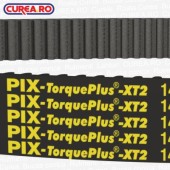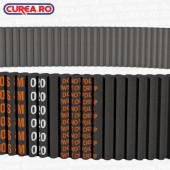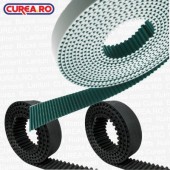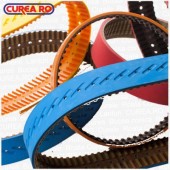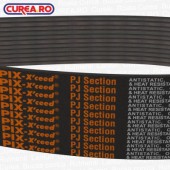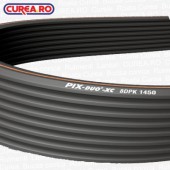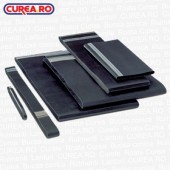Flat, ribbed and toothed belts
General information
In the product group of flat, ribbed and toothed belts, there are power transmissions with a different design than V-belts. The flat belt is the "mother of all drive belts", originally made of leather, nowadays it is made of rubber and fabric. The advantage is that it turns well even on a relatively smaller pulley, the disadvantage is that it moves on the pulley and can easily slip off it... It can transmit less torque than V-belts, but it tolerates slipping well. Since it is not often used nowadays, it is relatively expensive. Ribbed belts combine the advantages of flat belts with the positive properties of V-belts. It's like tiny V-belts glued together...
General information
In the product group of flat, ribbed and toothed belts, there are power transmissions with a different design than V-belts. The flat belt is the "mother of all drive belts", originally made of leather, nowadays it is made of rubber and fabric. The advantage is that it turns well even on a relatively smaller pulley, the disadvantage is that it moves on the pulley and can easily slip off it... It can transmit less torque than V-belts, but it tolerates slipping well. Since it is not often used nowadays, it is relatively expensive. Ribbed belts combine the advantages of flat belts with the positive properties of V-belts. It's like tiny V-belts glued together...
They can also be used on small-diameter pulleys and can transmit large forces. It is often found as a drive belt for machines and equipment. Timing belts are a combination of V-belt drive and chain drive. It is not only friction that transfers the power, but also the transverse ribs located on the belt cling to the drive wheel, so it is able to transmit nearly the same driving forces as the V-belt drive in a smaller, much more compact design. Common in small electric machines.
Double-sided ribbed belts are mostly used in the food industry. Double toothed timing belts are toothed on both sides and can transmit drive on both sides. We use them when we want to drive one wheel in one direction and the other wheel in another direction... They are most often used on lawnmowers and milling machines. Running meter toothed belts are mostly used for linear movements, but the polyurethane versions can be made endless by baking, so they can also be used as drive belts. In the Special toothed belts group, you can find the toothed versions of Cable Pulling Belts, Foil Pulling Belts, and Mill Industry Grinding Roller Belts.
They can also be used on small-diameter pulleys and can transmit large forces. It is often found as a drive belt for machines and equipment. Timing belts are a combination of V-belt drive and chain drive. It is not only friction that transfers the power, but also the transverse ribs located on the belt cling to the drive wheel, so it is able to transmit nearly the same driving forces as the V-belt drive in a smaller, much more compact design. Common in small electric machines.
Double-sided ribbed belts are mostly used in the food industry. Double toothed timing belts are toothed on both sides and can transmit drive on both sides. We use them when we want to drive one wheel in one direction and the other wheel in another direction... They are most often used on lawnmowers and milling machines. Running meter toothed belts are mostly used for linear movements, but the polyurethane versions can be made endless by baking, so they can also be used as drive belts. In the Special toothed belts group, you can find the toothed versions of Cable Pulling Belts, Foil Pulling Belts, and Mill Industry Grinding Roller Belts.
News
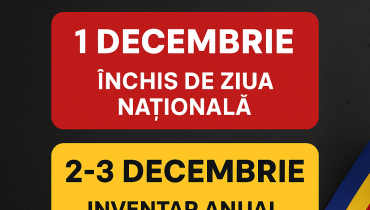 INVENTAR ANUAL
1 Decembrie - Ziua națională a României
2-3 Decembrie - inventar anual
⏰ În cazul comenzilor plasate în această perioadă, data preconizată de livrare va apărea incorect în mail-ul de confirmare trimisă automat despre comanda. (Termenul limită de livrare va fi amânat)
Mulțumim pentru înțelegere!
next
INVENTAR ANUAL
1 Decembrie - Ziua națională a României
2-3 Decembrie - inventar anual
⏰ În cazul comenzilor plasate în această perioadă, data preconizată de livrare va apărea incorect în mail-ul de confirmare trimisă automat despre comanda. (Termenul limită de livrare va fi amânat)
Mulțumim pentru înțelegere!
next
 De ce nu putem identifica majoritatea curelelor trapezoidale pentru tractoare de tuns gazon dupa tipul de mașină?
Obiectivul producătorilor de mașini este, în general, acela de a se asigura că prețul de vânzare al pieselor de schimb pentru mașinile pe care le comercializează acoperă costurile de furnizare a pieselor și, dacă este posibil, să genereze un profit. Ei pot face acest lucru prin a nu eticheta piesele standard utilizate în mașină cu denumirile lor standard, ci prin utilizarea unor identificatori unici și numere de piese care au sens doar pentru specialiștii familiarizați cu produsul.
next
De ce nu putem identifica majoritatea curelelor trapezoidale pentru tractoare de tuns gazon dupa tipul de mașină?
Obiectivul producătorilor de mașini este, în general, acela de a se asigura că prețul de vânzare al pieselor de schimb pentru mașinile pe care le comercializează acoperă costurile de furnizare a pieselor și, dacă este posibil, să genereze un profit. Ei pot face acest lucru prin a nu eticheta piesele standard utilizate în mașină cu denumirile lor standard, ci prin utilizarea unor identificatori unici și numere de piese care au sens doar pentru specialiștii familiarizați cu produsul.
next
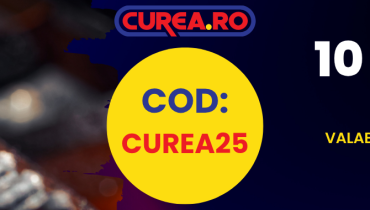 CUPON PROMOȚIE 10 RON
Comandă de cel puțin 130 Ron , folosește codul de cupon: CUREA25 , și ai reducere 10 RON
next
CUPON PROMOȚIE 10 RON
Comandă de cel puțin 130 Ron , folosește codul de cupon: CUREA25 , și ai reducere 10 RON
next
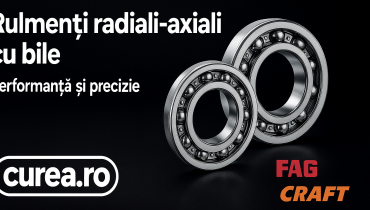 Rulmenții radiali-axiali cu bile – performanță, precizie și durabilitate
Într-un mediu industrial tot mai competitiv, alegerea unor rulmenți cu bile și rulmenți radiali de calitate este o investiție în durabilitate, eficiență și performanță. Brandurile FAG și CRAFT, disponibile pe curea.ro
next
Rulmenții radiali-axiali cu bile – performanță, precizie și durabilitate
Într-un mediu industrial tot mai competitiv, alegerea unor rulmenți cu bile și rulmenți radiali de calitate este o investiție în durabilitate, eficiență și performanță. Brandurile FAG și CRAFT, disponibile pe curea.ro
next
